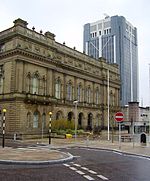Blackburn Cotton Exchange Building
BlackburnBlackburn with DarwenBuildings and structures in BlackburnBuildings and structures in Blackburn with DarwenCotton industry in England ... and 4 more
Grade II* listed buildings in LancashireHistory of Blackburn with DarwenListed buildings in LancashireUse British English from July 2023

The Cotton Exchange is a grade II listed building in Blackburn, England. It is located on King William Street, opposite the Town Hall. The building was used briefly as a cotton exchange, then a performance hall and cinema, before closing in 2005. It was bought by the Re:Source charity in 2015, and is currently used by community groups and as an event space.
Excerpt from the Wikipedia article Blackburn Cotton Exchange Building (License: CC BY-SA 3.0, Authors, Images).Blackburn Cotton Exchange Building
Museum Street,
Geographical coordinates (GPS) Address Website Nearby Places Show on map
Geographical coordinates (GPS)
| Latitude | Longitude |
|---|---|
| N 53.74997 ° | E -2.48508 ° |
Address
The Exchange
Museum Street
BB1 7JN , Four Lane Ends
England, United Kingdom
Open on Google Maps








